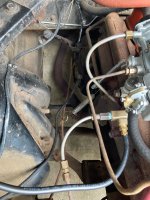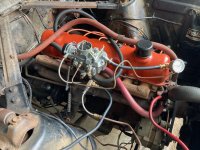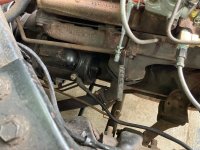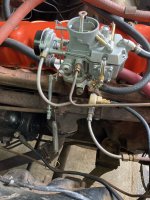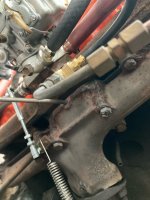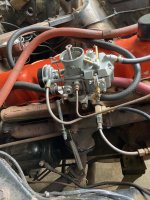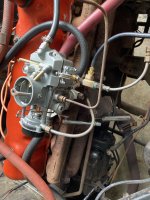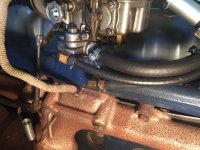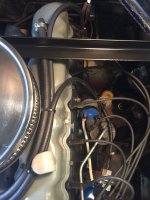My father and I have been working to get a '65 fastback Mustang with a 200 CID that has been in his garage for more than 40 years running again.
I am relatively certain that the Autolite 1100 we are using has been rebuilt properly and is adjusted reasonably well.
The car will run, but not great. At this point we have traced and fixed all of the vacuum leaks, and when running it is pulling between 17-20 mmhg at the manifold (I installed a T fitting to allow for attaching a gauge that you can see in the pictures).
The car is getting between 3.5 and 4 PSI of fuel (an inline pressure gauge was installed).
I believe that the issue (at least in part, there still could be timing issues, etc.) at this point is the throttle linkage.
The arm from the linkage across the firewall and to the pedal seems to be sitting very low, resting directly on the exhaust manifold at idle.
We have a new return spring installed (supposedly the correct one for a 200, from NPD) to what appears to be a cobbled wire attachment point on a transmission line (C4 automatic). I have seen some pictures here where the spring is attached through a hole in the flange where the exhaust meets the manifold. There is no such hole on this car, and when hooked into position there, the spring does not supply enough tension for the gas pedal to return properly (it hangs).
When adjusting the throttle linkage, the car either runs with a high idle (around 2K) or stalls out completely, and no amount of adjusting on the carb idle screw has any effect whatsoever. If you hold the carb in position you can get it to run better, but the arm bottoming out on the manifold seems to be preventing us from getting it attached that way. We have an new adjustable linkage for the 200, purchased from CJ pony parts (FM-EA006) but can't seem to get the combination right.
I'm attaching a few pictures of our setup. It has the stock Load-O-Matic distributor.
Any help from the experts would be greatly appreciated. Could this be the problem? Is the linkage bar sitting on the manifold correct?
Thank you all so much!!
Dan and his Dan
I am relatively certain that the Autolite 1100 we are using has been rebuilt properly and is adjusted reasonably well.
The car will run, but not great. At this point we have traced and fixed all of the vacuum leaks, and when running it is pulling between 17-20 mmhg at the manifold (I installed a T fitting to allow for attaching a gauge that you can see in the pictures).
The car is getting between 3.5 and 4 PSI of fuel (an inline pressure gauge was installed).
I believe that the issue (at least in part, there still could be timing issues, etc.) at this point is the throttle linkage.
The arm from the linkage across the firewall and to the pedal seems to be sitting very low, resting directly on the exhaust manifold at idle.
We have a new return spring installed (supposedly the correct one for a 200, from NPD) to what appears to be a cobbled wire attachment point on a transmission line (C4 automatic). I have seen some pictures here where the spring is attached through a hole in the flange where the exhaust meets the manifold. There is no such hole on this car, and when hooked into position there, the spring does not supply enough tension for the gas pedal to return properly (it hangs).
When adjusting the throttle linkage, the car either runs with a high idle (around 2K) or stalls out completely, and no amount of adjusting on the carb idle screw has any effect whatsoever. If you hold the carb in position you can get it to run better, but the arm bottoming out on the manifold seems to be preventing us from getting it attached that way. We have an new adjustable linkage for the 200, purchased from CJ pony parts (FM-EA006) but can't seem to get the combination right.
I'm attaching a few pictures of our setup. It has the stock Load-O-Matic distributor.
Any help from the experts would be greatly appreciated. Could this be the problem? Is the linkage bar sitting on the manifold correct?
Thank you all so much!!
Dan and his Dan

